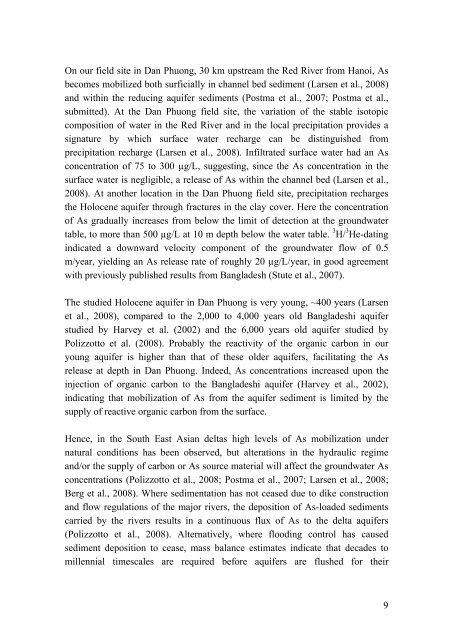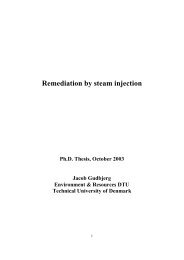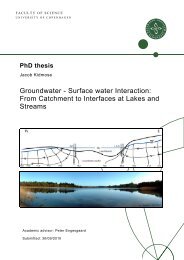Groundwater arsenic in the Red River delta, Vietnam ... - Fiva
Groundwater arsenic in the Red River delta, Vietnam ... - Fiva
Groundwater arsenic in the Red River delta, Vietnam ... - Fiva
Create successful ePaper yourself
Turn your PDF publications into a flip-book with our unique Google optimized e-Paper software.
On our field site <strong>in</strong> Dan Phuong, 30 km upstream <strong>the</strong> <strong>Red</strong> <strong>River</strong> from Hanoi, As<br />
becomes mobilized both surficially <strong>in</strong> channel bed sediment (Larsen et al., 2008)<br />
and with<strong>in</strong> <strong>the</strong> reduc<strong>in</strong>g aquifer sediments (Postma et al., 2007; Postma et al.,<br />
submitted). At <strong>the</strong> Dan Phuong field site, <strong>the</strong> variation of <strong>the</strong> stable isotopic<br />
composition of water <strong>in</strong> <strong>the</strong> <strong>Red</strong> <strong>River</strong> and <strong>in</strong> <strong>the</strong> local precipitation provides a<br />
signature by which surface water recharge can be dist<strong>in</strong>guished from<br />
precipitation recharge (Larsen et al., 2008). Infiltrated surface water had an As<br />
concentration of 75 to 300 μg/L, suggest<strong>in</strong>g, s<strong>in</strong>ce <strong>the</strong> As concentration <strong>in</strong> <strong>the</strong><br />
surface water is negligible, a release of As with<strong>in</strong> <strong>the</strong> channel bed (Larsen et al.,<br />
2008). At ano<strong>the</strong>r location <strong>in</strong> <strong>the</strong> Dan Phuong field site, precipitation recharges<br />
<strong>the</strong> Holocene aquifer through fractures <strong>in</strong> <strong>the</strong> clay cover. Here <strong>the</strong> concentration<br />
of As gradually <strong>in</strong>creases from below <strong>the</strong> limit of detection at <strong>the</strong> groundwater<br />
table, to more than 500 μg/L at 10 m depth below <strong>the</strong> water table. 3 H/ 3 He-dat<strong>in</strong>g<br />
<strong>in</strong>dicated a downward velocity component of <strong>the</strong> groundwater flow of 0.5<br />
m/year, yield<strong>in</strong>g an As release rate of roughly 20 μg/L/year, <strong>in</strong> good agreement<br />
with previously published results from Bangladesh (Stute et al., 2007).<br />
The studied Holocene aquifer <strong>in</strong> Dan Phuong is very young, ~400 years (Larsen<br />
et al., 2008), compared to <strong>the</strong> 2,000 to 4,000 years old Bangladeshi aquifer<br />
studied by Harvey et al. (2002) and <strong>the</strong> 6,000 years old aquifer studied by<br />
Polizzotto et al. (2008). Probably <strong>the</strong> reactivity of <strong>the</strong> organic carbon <strong>in</strong> our<br />
young aquifer is higher than that of <strong>the</strong>se older aquifers, facilitat<strong>in</strong>g <strong>the</strong> As<br />
release at depth <strong>in</strong> Dan Phuong. Indeed, As concentrations <strong>in</strong>creased upon <strong>the</strong><br />
<strong>in</strong>jection of organic carbon to <strong>the</strong> Bangladeshi aquifer (Harvey et al., 2002),<br />
<strong>in</strong>dicat<strong>in</strong>g that mobilization of As from <strong>the</strong> aquifer sediment is limited by <strong>the</strong><br />
supply of reactive organic carbon from <strong>the</strong> surface.<br />
Hence, <strong>in</strong> <strong>the</strong> South East Asian <strong>delta</strong>s high levels of As mobilization under<br />
natural conditions has been observed, but alterations <strong>in</strong> <strong>the</strong> hydraulic regime<br />
and/or <strong>the</strong> supply of carbon or As source material will affect <strong>the</strong> groundwater As<br />
concentrations (Polizzotto et al., 2008; Postma et al., 2007; Larsen et al., 2008;<br />
Berg et al., 2008). Where sedimentation has not ceased due to dike construction<br />
and flow regulations of <strong>the</strong> major rivers, <strong>the</strong> deposition of As-loaded sediments<br />
carried by <strong>the</strong> rivers results <strong>in</strong> a cont<strong>in</strong>uous flux of As to <strong>the</strong> <strong>delta</strong> aquifers<br />
(Polizzotto et al., 2008). Alternatively, where flood<strong>in</strong>g control has caused<br />
sediment deposition to cease, mass balance estimates <strong>in</strong>dicate that decades to<br />
millennial timescales are required before aquifers are flushed for <strong>the</strong>ir<br />
9





